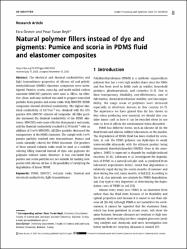Natural polymer fillers instead of dye and pigments: Pumice and scoria in PDMS fluid and elastomer composites

View/
Access
info:eu-repo/semantics/openAccesshttp://creativecommons.org/licenses/by/3.0/us/Date
2023Metadata
Show full item recordAbstract
The electrical and thermal conductivities and light transmittance properties of silicone oil and polydimethylsiloxane (PDMS) elastomer composites were investigated. Pumice, scoria, nano-Ag, and multi-walled carbon nanotube (MWCNT) particles were used as fillers. An effective, clean, and easy method was used to prepare nanosized particles from pumice and scoria rocks. Only MWCNT-PDMS composites showed electrical conductivity. The highest electrical conductivity of 24.7 S·m-1 was obtained with the 25% pumice-10% MWCNT-silicone oil composite. All filler particles increased the thermal conductivity of the PDMS elastomer. MWCNTs were more effective than pumice and scoria, and the thermal conductivity reached 0.62W·(m·K)-1 with an addition of 3 wt% MWCNTs. All filler particles decreased the transparency of the PDMS elastomer. The sample with 5 wt% pumice particles reached zero transmittance. Pumice and scoria naturally colored the PDMS elastomer. The powders of these natural volcanic rocks could be used as a suitable coloring filling material instead of dyes and pigments for polymers without waste. However, it was concluded that pumice and scoria particles are not suitable for making composites with silicone oil due to the possibility of catalyzing the degradation of linear PDSM.
Source
Green Processing and SynthesisVolume
12Issue
1Collections
The following license files are associated with this item:


















